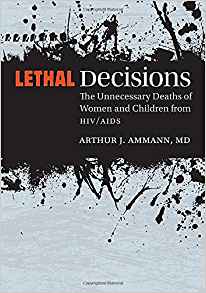 Arthur J. Ammann, Lethal Decisions: The Unnecessary Deaths of Women and Children from HIV/AIDS (Nashville: Vanderbilt University Press, 2017), 376pp.
Arthur J. Ammann, Lethal Decisions: The Unnecessary Deaths of Women and Children from HIV/AIDS (Nashville: Vanderbilt University Press, 2017), 376pp.
Early in 1982, Arthur Ammann, then the Director of the Pediatric Immunology and Clinical Research Center at the University of California Medical Center in San Francisco, treated a woman who was a prostitute and intravenous drug user and three of her children. All four presented with unusual deficiencies in their immune systems that were aggravated by opportunistic infections that did not fit normal medical models of disease — the same patterns that he had been studying in gay men after Michael Gottlieb of UCLA was the first person to identify AIDS as a new disease in a June 5, 1981 publication.
Ammann determined that the mother and all three children had contracted AIDS. This was a tragic diagnosis because the disease was at that time fatal. Equally devastating was a terrifying conclusion, hotly contested and very controversial at the time, that HIV-AIDS was not limited to adults. Ammann had determined that the disease had passed from the mother to her children as an "acquired" and not an "inherited" disease. He thus documented the first cases of AIDS transmission from mother to infant.
On December 10, 1982, in a separate case of an infant who had received more than twenty blood transfusions from nineteen different donors, Ammann identified the first case of AIDS transmission by blood transfusion. This too was a tragic and controversial discovery that many people denied. The New England Journal of Medicine refused to publish his results, as did the British journal Lancet until it relented and did publish the article on April 30, 1983. And not until 1985 was there a test approved for HIV for use in blood banks.
For the last thirty-five years, Ammann has been not just a leading expert at the center of the AIDS crisis, but also a tireless and vocal activist, especially for the women and children who have been impacted by HIV-AIDS but also ignored, and especially women and children in the poorest parts of the poorest countries of the world (like war zones). His friend and colleague Gottlieb has called him "the conscience of the pediatric HIV epidemic." This book is Ammann's highly personal, deeply passionate, and even polemical history of the defining public health crisis of our generation.
The epidemic resulted in remarkable achievements by dedicated and brilliant scientists. Indeed, "all the scientific advances, tools, and knowledge necessary to begin the process of eradicating HIV in infants and children were in place by 1996" (272). ZDV, to take just one important example, was the first antiretroviral drug approved by the FDA, in record time, in 1987.
But consider this stark reminder — today "an estimated twenty-one million (59 percent of) HIV-infected individuals are still not on any treatment (UNAIDS 2016)" (277). If you are lucky enough to live in a wealthy country, you have access to state of the art drugs that now control HIV. Magic Johnson, for example, publicly announced that he had HIV way back in 1991. But in parts of Africa HIV is still a "hyper epidemic" (281), and treating children with the highly effective ZDV has been mired in needless controversy.
Ammann's history explains how this radical disparity came to pass. Looking back, he now sees "how difficult it can be, in spite of scientific evidence and personal tragedy, to move large and cumbersome institutions and the individuals working within them into action to protect the public from dangers" (26). There are two separate chapters on "denialism" within the medical-scientifc community. The many manifestations of bureaucratism loom large. Turf wars, research funding, government gridlock, drug development, issues of confidentiality and liability, gender based violence, self interest, conflicts of interest, and counterproductive treatment guidelines by WHO — all these combined to create a perfect storm of a catastrophic epidemic.
For Ammann, "the story told in this book is one of hope and caution" (293). There have been both "extraordinary advances" and "tragic consequences" since 1981. For a long time now we have had the means to identify and treat every individual who is infected with HIV. Ammann reminds us that there's no excuse not to do exactly that.


